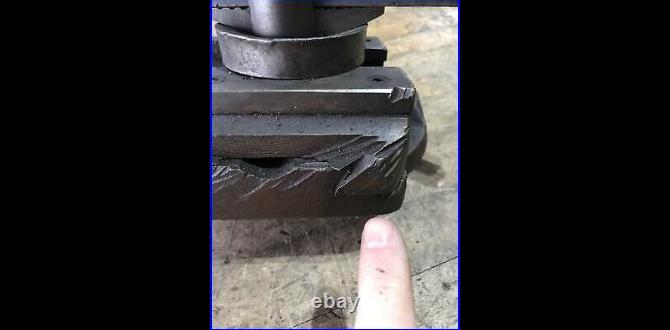Quick Summary: To effectively reduce Inconel chatter when using a carbide end mill, focus on selecting the right tool geometry, employing proper cutting parameters, ensuring machine rigidity, and utilizing good coolant strategies. A stub-length, high-performance carbide end mill with a suitable coating is your best bet for tackling this tough-to-machine alloy.
Taming the Rumble: How to Eliminate Inconel Chatter with Your Carbide End Mill
When you’re working with tough materials like Inconel, especially in your home workshop or for a DIY project, you might run into a frustrating problem: chatter. This is that annoying vibration that makes a horrible noise, leaves nasty marks on your workpiece, and generally ruins your finish. It feels like your machine is fighting you! But don’t worry, you can overcome this. This guide will show you exactly how to use your carbide end mill to say goodbye to Inconel chatter, making your machining smooth and successful.
We’ll walk through everything from picking out the perfect end mill to setting up your machine for success. By the end, you’ll feel confident tackling Inconel and achieving those clean, precise cuts you’re aiming for.
Why Does Inconel Love to Chatter?
Inconel is a superalloy, meaning it’s tougher, stronger, and more heat-resistant than your average metal. This makes it fantastic for high-temperature applications (like jet engines!), but it’s a nightmare to machine. It has a tendency to work-harden, meaning it gets even harder the more you cut it. This, combined with its high tensile strength and low thermal conductivity, creates a perfect storm for chatter.
When your cutting tool engages with the material, small variations in cutting force can cause the tool or workpiece to flex. Because Inconel resists this flex, it can snap back, creating a vibration – chatter. This cycle repeats very quickly, leading to that awful noise and a rough surface finish. It’s like trying to saw through a hardened steel rod with a flimsy saw blade; it just won’t be smooth.
The Champion Tool: Choosing the Right Carbide End Mill
Not all end mills are created equal, especially when you’re battling Inconel. For this material, you want a carbide end mill, and not just any carbide end mill. We’ll be looking for specific features designed to handle the demands of superalloys.
Key Features of an Inconel-Ready Carbide End Mill:
- Material: Solid carbide is essential. It’s much harder and more rigid than High-Speed Steel (HSS), allowing it to withstand the heat and forces involved.
- Geometry: Look for mills designed for high-temp alloys. This often means:
- Higher Helix Angle (30°-45°): A steeper helix helps “shears” the material more effectively, reducing cutting forces and improving chip evacuation.
- Variable Pitch or Uneven Tooth Spacing: This is a game-changer for chatter reduction. By not having teeth spaced evenly, it breaks up the harmonic vibrations that cause chatter.
- Specialized Corner Radii or Chamfers: These features help to reduce the depth of cut per tooth, leading to a smoother engagement with the material.
- Coatings: A good coating is crucial. It reduces friction, increases hardness, and improves heat resistance.
- AlTiN (Aluminum Titanium Nitride) or TiAlN (Titanium Aluminum Nitride): These are excellent choices for Inconel as they provide a tough, heat-resistant layer.
- ZrN (Zirconium Nitride): Can also be effective, offering good lubricity and wear resistance.
- Length: For Inconel, stub-length end mills are often preferred. They are shorter and have a larger core diameter, making them much more rigid and less prone to vibration. Think of a short, stout broomstick versus a long, thin one – the short one is harder to bend.
- Number of Flutes: For hard materials like Inconel, you’ll typically want fewer flutes. 2 or 3 flutes are common. This leaves more space for chip evacuation and prevents the flutes from getting clogged, which can lead to tool breakage and chatter.
When you’re searching, look for terms like “High-Performance,” “Superalloy,” or “Aerospace” end mills. For example, a carbide end mill 1/8 inch, 1/4 shank stub length for Inconel 718 would be a good starting point if your project requires those dimensions. The stub length and the specific design for Inconel will be key to reducing chatter.
Setting the Stage: Machine Rigidity is King
Your brand-new, super-sharp carbide end mill is only as good as the machine holding it. A wobbly machine is a chatter-making machine. Before you even think about cutting, make sure your setup is as rigid as possible.
Checking and Improving Machine Rigidity:
- Spindle Runout: Ensure your spindle isn’t worn out. Excessive runout (wobble) is a direct cause of chatter and poor finish. If you suspect an issue, consult your machine’s manual or a technician.
- Tool Holder Rigidity: Use a high-quality tool holder, like a shrink-fit or a good quality collet chuck, rather than a standard ER collet if possible. The tighter the grip and the less overhang, the better.
- Workholding: How you hold your Inconel workpiece is critical. Ensure it’s clamped down extremely securely with no chance of movement. Use vises, clamps, or fixtures specifically designed for heavy-duty machining. Avoid long, slender workpieces that can flex.
- Machine Base: Is your milling machine bolted down firmly to a sturdy base or workbench? A lighter machine needs to be anchored to avoid vibrating itself.
- Dull Tooling or Fixtures: Double-check that any other tooling or fixtures you’re using aren’t worn or damaged. Even a slight looseness can contribute to vibration.
Think of it this way: every tiny bit of flex in your machine or workholding gets amplified during the cutting process, especially with a tough material like Inconel. A rigid setup minimizes this flex, allowing the cutting tool to do its job cleanly.
Dialing It In: Cutting Parameters That Beat Chatter
This is where the magic happens. Getting your cutting speed and feed rate right is probably the most impactful way to stop chatter, besides having the right tool.
Understanding Speed and Feed:
- Cutting Speed (Surface Speed): This is how fast the edge of the end mill is moving relative to the workpiece. Inconel requires relatively slow cutting speeds compared to softer metals.
- Feed Rate: This is how fast the tool advances into the material. You generally want a relatively high feed rate per tooth.
Recommended Starting Parameters for Inconel (with Carbide End Mills):
These are very general starting points. Always refer to the end mill manufacturer’s recommendations for the specific tool you are using. Manufacturers like Sandvik Coromant or Gühring provide excellent data.
For a stub-length carbide end mill designed for Inconel:
- Cutting Speed (SfM – Surface Feet per Minute): Start very conservatively, perhaps around 20-50 SFM. This might seem slow, but Inconel demands it.
- Feed Rate per Tooth (ipt – inches per tooth): Aim for a relatively aggressive feed per tooth, often in the range of 0.003″ to 0.006″ for smaller diameter end mills (like 1/4″). For a 1/4″ shank stub length, you might start around 0.004″ ipt.
- Depth of Cut (ap): Keep this shallow. For Inconel, axial depth of cut (how deep the tool goes lengthwise) should be low, perhaps only 0.050″ to 0.150″ for a 1/4″ end mill. Radial depth of cut (how much of the tool’s diameter is engaged sideways) should also be conservative, often 20-50% of the tool diameter.
- Spindle Speed (RPM): You’ll calculate this based on your cutting speed. The formula is: RPM = (Cutting Speed 3.82) / Tool Diameter (in inches).
- Feed Rate (ipm – inches per minute): You’ll calculate this too: IPM = Feed Rate per Tooth Number of Flutes RPM.
Example Calculation for a 1/4″ Stub End Mill:
- Assume: 30 SFM, 0.004″ ipt, 4 flutes.
- RPM = (30 3.82) / 0.25 = 458.4 RPM (round to 450-460 RPM)
- IPM = 0.004″ 4 458.4 RPM = 7.33 IPM (round to 7 IPM)
Key Strategy: Avoid taking extremely light “dusting” passes, as this can encourage rubbing and chatter. Conversely, don’t push too hard into a material that wants to work-harden. Aim for a chip load that is substantial enough to form a proper chip, rather than a powder. If you hear chatter, the first thing to do is increase the feed rate slightly or decrease the spindle speed. Making small, incremental adjustments is key.
The Role of Coolant and Chip Evacuation
Machining Inconel generates a lot of heat. Proper cooling is not just about tool life; it also contributes to a more stable cutting process and helps to clear chips, preventing them from recutting and causing surface finish issues.
Coolant Strategies for Inconel:
- Flood Coolant: A copious amount of high-pressure coolant directed right at the cutting zone. This is the most common and effective method. Use a coolant specifically designed for high-temperature alloys, often with good lubricity.
- Through-Spindle Coolant (TSC): If your machine has TSC, use it! This delivers coolant directly through the tool, which is incredibly effective for chip flushing and cooling.
- MQL (Minimum Quantity Lubrication): For some applications, a fine mist of specialized lubricant can be used. However, for difficult Inconel machining, flood coolant is generally preferred.
- Chip Evacuation: Ensure your chips are being cleared effectively. If chips pack up in the flutes or the workpiece, they can cause rubbing, heat buildup, and chatter. High pressure coolant is your best friend here.
A well-chosen coolant not only cools but also lubricates, reducing friction and forces at the cutting edge. This smoother cutting action directly combats chatter.
Step-by-Step Approach to Reducing Chatter
Let’s put it all together. Here’s a practical, step-by-step guide to approach machining Inconel and minimizing chatter.
Step 1: Select the Right Tool
- Choose a stub-length, high-performance carbide end mill with a special geometry for Inconel (e.g., variable pitch, high helix).
- Ensure it has an appropriate coating like AlTiN.
- Verify it’s the correct size for your job.
Step 2: Prepare Your Machine and Workholding
- Ensure your spindle and tool holders are in good condition and offer maximum rigidity.
- Securely clamp your Inconel workpiece. No movement allowed!
- Bolt down your milling machine if it’s a lighter benchtop model.
Step 3: Determine Initial Cutting Parameters
- Consult the end mill manufacturer’s data for recommended SFM and chip load (ipt) for Inconel.
- Use your machine’s information or an online calculator to determine initial RPM and IPM.
- Set conservative depths of cut (axial and radial).
Step 4: Set Up Coolant
- Prepare a generous supply of appropriate flood coolant.
- If available, set up through-spindle coolant.
- Position nozzles to direct coolant precisely at the cutting zone.
Step 5: Make the First Cut (Listen and Observe!)
- Start your spindle.
- Engage the feed slowly.
- Listen carefully. Is there any buzzing, ringing, or rough noise? That’s chatter.
- Observe the chip formation. Are they forming well, or are they powdery or stringy?
- Check the surface finish on the workpiece after the first pass.
Step 6: Adjust Parameters Based on Results
- If you hear chatter:
- Try increasing the feed rate (IPM) slightly (e.g., 5-10%).
- Try decreasing the spindle speed (RPM) slightly (e.g., 5-10%).
- Consider increasing the radial depth of cut (if possible within tool/machine limits) to engage more of the cutting edge.
- Ensure coolant is flowing effectively; a lack of lubrication can cause chatter.
- If the finish is poor but no chatter:
- You might be running too fast, causing heat buildup. Try a slightly lower SFM or RPM.
- Your feed rate might be too low, causing rubbing. Try increasing ipt.
- If chips are packing or look burnt:
- Increase coolant flow.
- Consider a slightly higher feed rate to generate a larger chip.
- Ensure you are not taking too deep a cut, which can hinder chip evacuation.
Step 7: Iterate and Refine
Machining Inconel is an iterative process. Make one adjustment at a time and see its effect. Keep a log of your settings and results. What works for one Inconel application might need tweaking for another.
Common Chatter Causes and Quick Fixes (Table)
Here’s a quick reference to common chatter culprits and how to address them:
| Symptom/Cause | Quick Fixes |
|---|---|
| Machine/Workholding Flex | Increase clamping force. Use short, rigid tooling. Ensure machine is anchored. |
| Tool Too Long / Poor Rigidity | Use stub-length end mills. Use a rigid tool holder (shrink fit, high-quality collet chuck). Minimize tool overhang. |
| Cutting Speed Too High | Reduce RPM. |
| Feed Rate Too Low | Increase IPM (feed rate). Aim for a healthy chip load (ipt). |
| Depth of Cut Too Small (especially radial) | Increase both axial and radial depth of cut (within machine/tool limits). |
| Worn Tooling | Replace end mill. |
| Poor Chip Evacuation | Increase coolant flow and pressure. Ensure chip passages are clear. Consider higher feed rate to create larger chips. |
| Incorrect End Mill Geometry | Use specialized Inconel end mills with variable pitch or high helix. |
Dealing with Specific Inconel Grades
While we’ve focused on Inconel generally, remember that there are different grades, such as Inconel 625 and Inconel 718. Inconel 718 is particularly challenging due to its precipitation hardening properties. The principles discussed – rigidity, specialized tooling, and careful parameter selection – apply to most Inconel grades, but you might find that Inconel 718 requires even more conservative starting speeds and a keen eye on those feed rates to avoid work hardening.
Always refer to reliable machining data sources. For instance, the National Machine Tool Builders’ Association (NMTBA) and various material suppliers offer valuable insights into machining specific aerospace alloys.
Frequently Asked Questions (FAQ)
Q1: What is the most common reason for chatter when milling Inconel?
A1: The most common reasons are a lack of rigidity in the machine setup (spindle, tool holder, workholding) and incorrect cutting parameters – usually cutting too fast or feeding too slow. Inconel’s tough nature amplifies any vibration.
Q2: Can I use a standard end mill to machine Inconel?
A2: It’s highly discouraged. Standard end mills, especially those made of HSS, will dull very quickly, generate excessive heat, and








